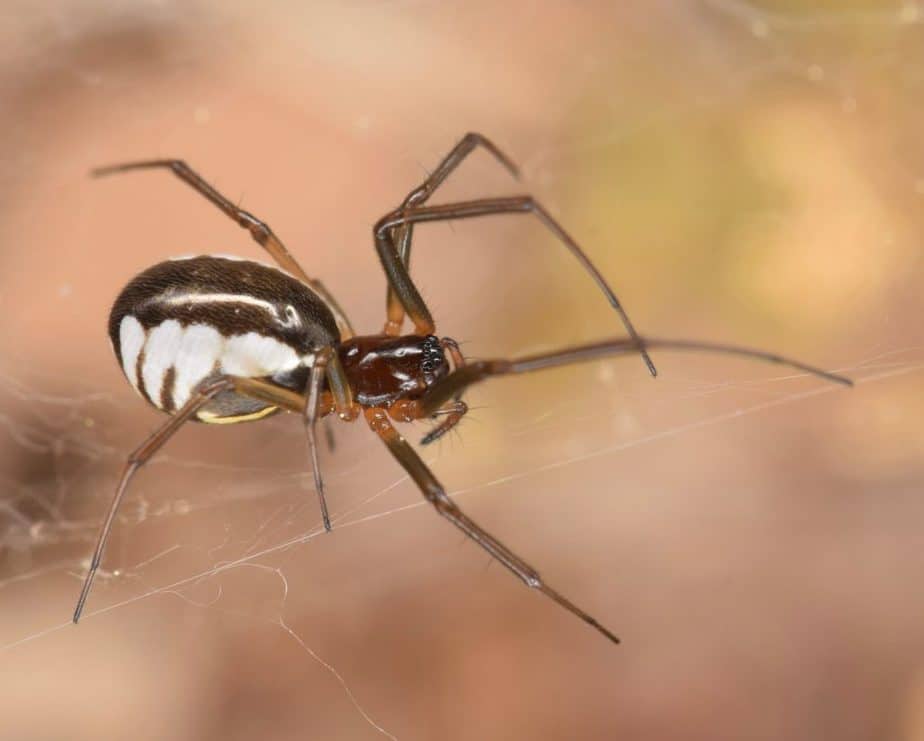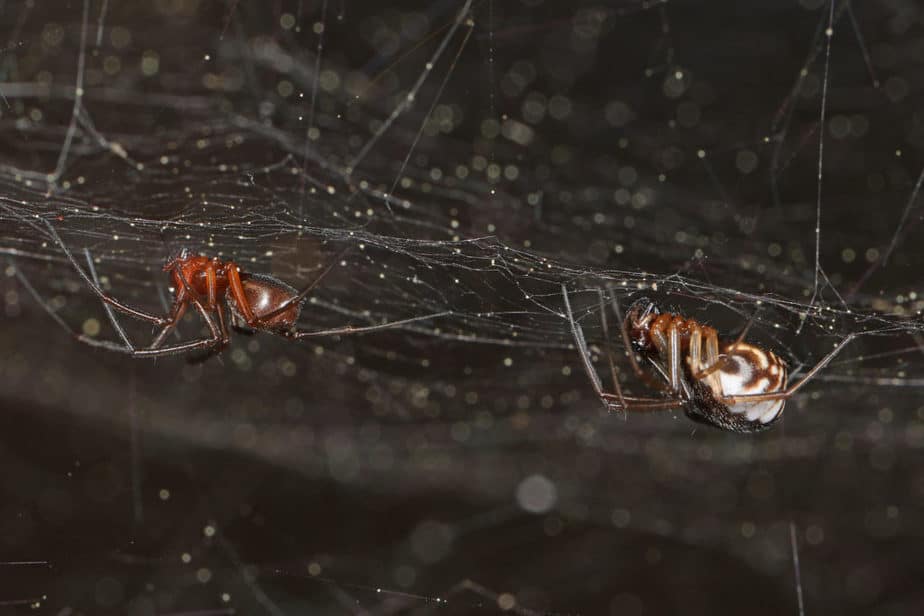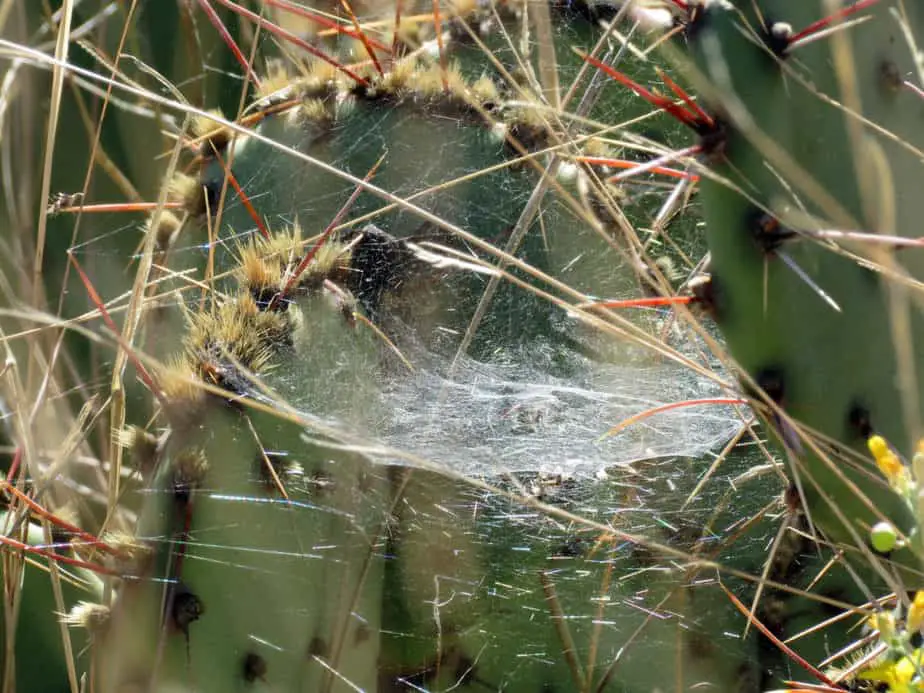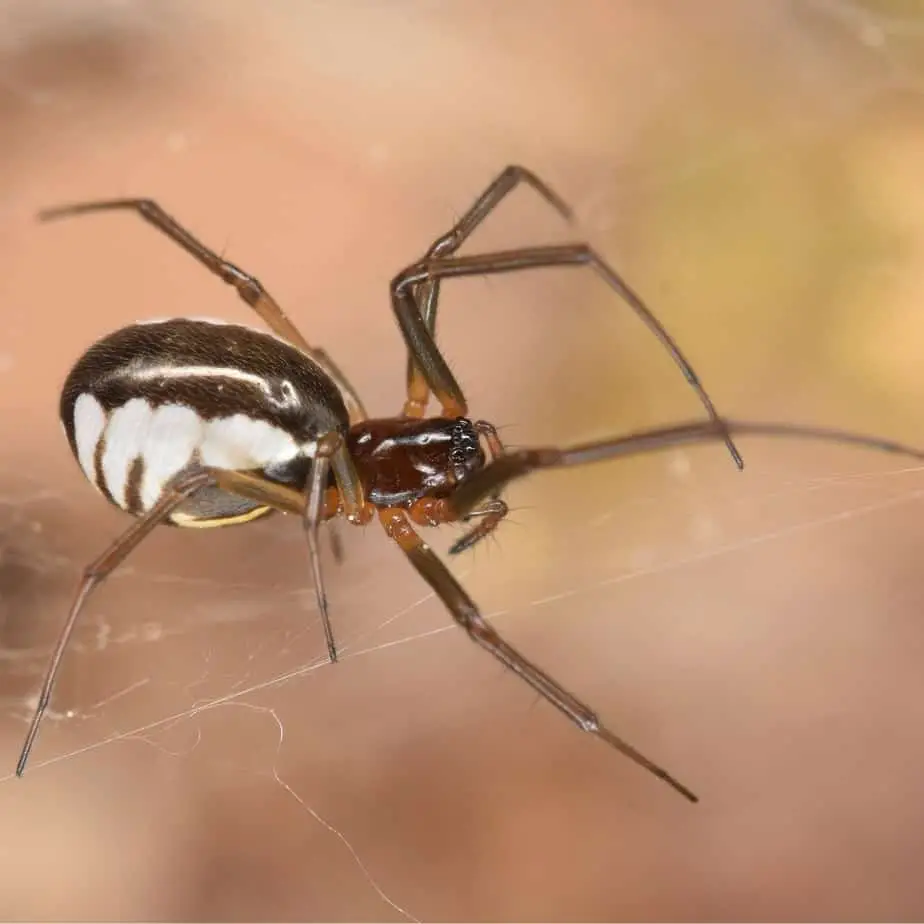The bowl and doily spiders, known as Frontinella pyramitela, are a small species of spiders that belong to the family of Linyphiidae. The common name of these spiders comes from its peculiar webs that have a bowl shape with a sheet-web or blanket (doily) beneath it. Like other sheet web weavers, Frotinella pyramitela spiders can live up to one year. These forest-dwelling spiders are mostly seen in summer, between July and August.
Description
Bowl and doily spiders are small and have a large, round and shiny abdomen. The abdomen is dark brown or black along the top with thick white vertical lines on the sides that look almost like inverted commas. Towards the bottom of the abdomen, the white markings often turn into a yellowish color. The exact color differs between individuals with some being mostly dark and yellow while some don’t have any yellow colorations at all.

The cephalothorax (head) is reddish brown and the legs are somewhat lighter brown. The legs are thin and appear relatively long.
Size
Like other Linyphiidae spiders, Frontinella pyramitela spiders are small spiders. Females reach a body size of up to 0.15 in (4 mm). The male spiders are slightly smaller than the females.
Web
These spiders can build large, distinct, and fascinating webs and they spin the webs usually several inches across, stretched between twigs. Male spiders hardly ever build webs but they cohabitate with females for extended periods of time.

The webs of the bowl and doily spider consists of two elements: an upper “bowl” shape and a lower part, a flat sheet-web, the “doily”. The spider sits in the lower web and waits for small insects to fly or crawl into the bowl web. As soon as that happens, the spider bites the prey from the underside. This two layer system provides safety for the bowl and doily spider while it can still quickly bite and immobilize any potential prey that enters the web.

Bite
The Frontinella pyramitela spiders aren’t dangerous to humans. Due to their small size, they only bite smaller insects and flies.
Distribution of the Bowl and Doily Spider
The bowl and doily spiders are common spiders throughout the continental United States except for the northern central region around the Dakotas. Namely, they can be found in the following states: Alabama, Arizona, Arkansas, California, Colorado, Connecticut, Delaware, Florida, Georgia, Illinois, Indiana, Kansas, Kentucky, Louisiana, Maine, Maryland, Massachusetts, Michigan, Minnesota, Mississippi, Missouri, Montana, Nebraska, Nevada, New Hampshire, New Jersey, New Mexico, New York, North Carolina, Ohio, Oklahoma, Pennsylvania, Rhode Island, South Carolina, Tennessee, Texas, Vermont, Virginia, West Virginia and Wisconsin.
Scientific classification of Frontinella pyramitela
- Kingdom: Animalia
- Phylum: Arthropoda
- Subphylum: Chelicerata
- Class: Arachnida
- Order: Araneae
- Infraorder: Araneomorphae
- Family: Linyphiidae
- Genus: Frontinella
- Species: Frontinella pyramitela
References
- Taxon details: World Spider Catalogue
- Binomial name from: Walckenaer, 1841
- Insectidentification.com
- http://academics.wellesley.edu/Biology/Web/Species/aspiderbowlanddoily.html


Found in Minnesota. Very small. The pic makes it look bigger than it is. Someone told me it’s a black widow.
I found this spider on the wall in my bathroom June 26, 2021.
Hello Shannon, thanks for reaching out. As written to you via email, this is most likely a male brown recluse spider. I’d suggest checking in darker corners of the house if it was a single male or if there are more recluses around.
Thanks for getting back to me. Ok today I found another spider on my bed, I’m attaching the picture. So far I believe I have had 3 spiders, I believe are brown recluse, all in different locations inside my house.
Hello Matt, thanks for getting in touch! What a great find! This is a bowl and doily spider (Frontinella pyramitela). It’s not a medically significant spider. Black widow spiders have a completely round abdomen. Juvenile widows may have some white markings but several lines, not thick stripes like Frontinella. You can read more about it here: https://usaspiders.com/frontinella-pyramitela-bowl-and-doily-spider/
What kind of spider is this? Found on fence on my back patio….north bay of San Francisco, CA
Huntington Beach, CA. This spider is webbed between 2 leaves on my lime tree, so it can it be a Bowl & Doily spider?
July 22, 2023. This summer I have been paying attention to the insects in my yard more than usual, and I’ve found these spiders in my back yard, I’m in Alaska !! Yes, I’ve used the Google picture search and the pictures of these spiders are the exact same as the spiders I’ve found. So far, I believe I e found 2 pairs, with 3 spiders in the first pair. So I’ve found 5 all together !! It says they aren’t in Alaska. But I guess they are now
July 22, 2023. This summer I found these spiders I never seen before in my backyard. I live in Alaska !! It says they don’t live in Alaska. But I guess they do now !! I used Google picture search to identify them. And the spiders I found are the exact same as the pictures here, and yes they hang upside down, they have white markings, with some of them having white and yellow. So far, I’ve found 2 pairs and along with the first pair was a third spider hanging around.
Tiny spider found on cardboard outside in south central Texas. Black with white markings. No red seen on spider.
my favorite spider is the false black widow i have some blue ribbon types as pets they are being trained to go against red state/red ribbon web spider species.
my favorite are the false black widow spiders especially the males im training mine to takedown redstate/red ribbon web spider species. mine are BLUE RIBBON SPIDERS
Greetings. Found this little one near a rain barrel outside. Beautiful colors.
Greetings. Found this little guy outside near a rain barrel. What is it?